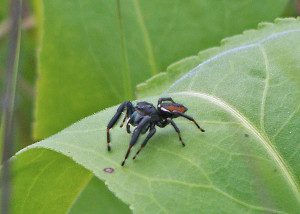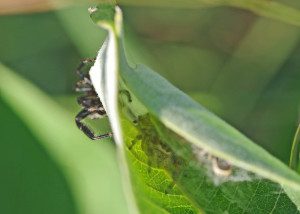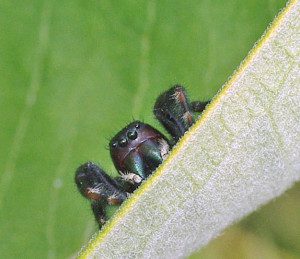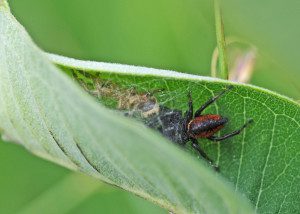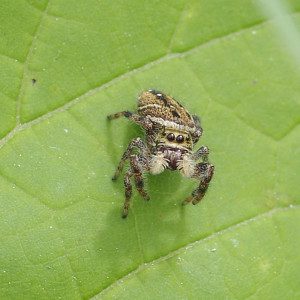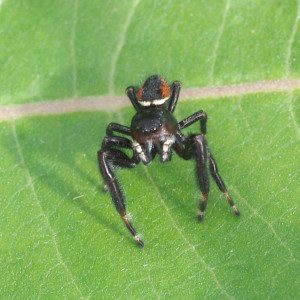Salutations, BugFans,
Recently, the BugLady sent a series of not-so-good pictures to her go-to spider guy, BugFan Mike, and his explanation inspired this episode. Thanks, Mike, as always.
The BugLady’s mailbox spider is a Bold/Daring jumping spider (Phidippus audax), but she has photographed other species, including the Brilliant jumping spider (Phidippus clarus) (“clarus” means “clear or bright”) on vegetation in her field.
Jumping spiders (family Salticidae) make silk, but they don’t make trap webs, preferring to spot their prey from afar and leap on it (they can cover 50 times their body length in a single bound). Jumping spiders have outstanding eyesight – better than dragonflies, insist some sources. The large, center pair of eyes faces straight forward, giving the spider excellent resolution, and they have good color vision. Since they are not tied to a single location by a web, they spend a lot of time on foot (they can remember visual landmarks and relocate their nests) or head-down, near the top of a plant, like a sailor in a crow’s nest. Whether they spot their prey from a perch or find it during a walk, they can spin a dragline when they jump – no “working without a net” for them!
Brilliant jumping spiders, a.k.a. Red and black jumping spiders, can be found from coast to coast but are more common in the eastern half of North America. Creatures of tallgrass prairies and open spaces, these spiders not only sit near the tops of plants, they put their nests (both males and females create nests called hibernacula) and egg sacs there, too. They can get away with being conspicuous because of their large populations.
We all know that spiders are devoted carnivores, but….. Turns out that there is a species of jumping spider in Central America that is mostly vegetarian (though it eats the occasional ant and it dabbles in cannibalism), and it’s not uncommon for juvenile jumping spiders of a variety of species to consume nutrient-rich nectar (from extrafloral nectaries, of previous BOTW fame) and pollen. After a successful hunt, a Brilliant jumping spider will settle down to feed (it can subdue earwig-sized prey), and it will eat more slowly if it is very hungry. Because of its size (large, for a Jumping spider) and numbers, P. clarus has been suggested as a biological control for some species of plant bugs (though its tendency towards cannibalism makes mass-production in the lab difficult).
In many spider species, an ardent male approaches the larger female cautiously and departs hastily once the deed is done (she, after all, needs protein). But, the pictures that the BugLady sent to BugFan Mike, taken in early July, showed a male P. clarus hanging around a milkweed leaf that was curled up and webbed together to make a nest, with a female inside. What, asked the BugLady, was going on?
Said Mike, “P. clarus males actually do pre-copulatory mate guarding. They mature earlier than females, and locate and guard a pre-adult female. Then they mate with her as soon as she molts to adulthood.”
When boy meets girl, he initiates courtship by waving his legs and flashing his iridescent mouthparts (chelicerae) at her and by vibrating his abdomen against the substrate. He reaches out to touch her, and she either parries or accepts his advances. If she’s ready, romance ensues. Females evaluate the vibrations; a male with longer legs vibrates more rapidly, indicating that he’s large. He assesses her age and size based on the pheromones she leaves on the silk she spins. Both males and females show a bias toward picking the biggest possible mate (a large male looks more “fit” to her and a large female looks “eggier” to him).
He also vibrates to intimidate possible rivals. Face-offs between males involve ritualized signals and responses, and physical encounters are sumo-esque – lots of pushing, some grappling. Research shows that males that have previously won male-male encounters tend to win again, and losers lose again, but size, and what BugFan Mike calls “home field advantage” factor in, too. When females interact, it’s less “scripted” and can be fatal.
What about those child brides? Early in the season, a wandering male may come across a hibernaculum occupied by a sub-adult female and either co-habit or build a nest on top of it, protecting the female from other males until she matures, mating within the nest.
Later in the season, males may find non-virgin females and initiate “extra-hibernacular” (the BugLady just made that word up) liaisons. Females that mate a second time often require a more earnest courtship (because females that have been protected within their nests generally mate with whoever’s protecting her, one study suggests that she may be “trading up” the second time, looking for a bigger male).
Females lay a clutch of 125+ eggs. The spiderlings stay in the nest for about a month after they hatch; the female guards the nest http://bugguide.net/node/view/224274/bgimage and dies shortly after the young leave it.
For a video of P. clarus shots see http://www.rkwalton.com/salticids/Phidippus_clarus.php. Bonus points if you can ID all the bird calls: It’s an interesting site to explore http://www.rkwalton.com/sitemap.php.
For a thorough, well-illustrated biography of P. clarus, see http://peckhamia.com/peckhamia/PECKHAMIA_113.1.pdf
For a story about some moths that fool jumping spiders by mimicking them, see: http://news.nationalgeographic.com/news/2007/02/070214-moths-mimic.html.
Kate Redmond, The BugLady
Bug of the Week archives:
http://www4.uwm.edu/

